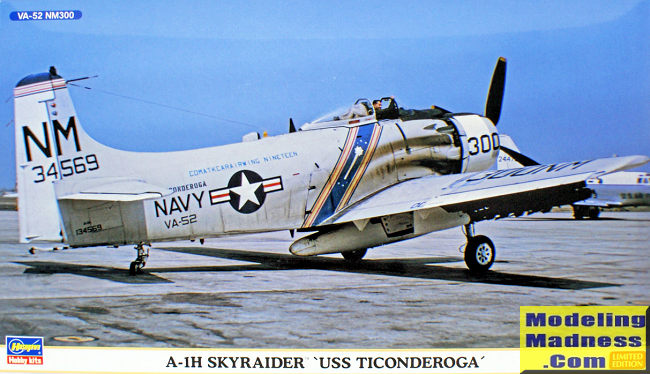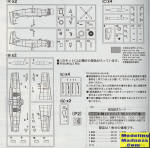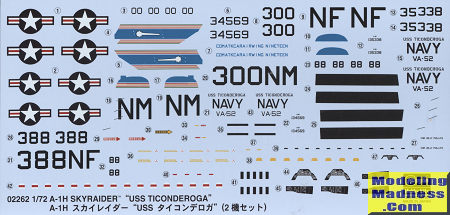
| KIT #: | 02262 |
| PRICE: | 4200 yen SRP |
| DECALS: | Two options |
| REVIEWER: | Scott Van Aken |
| NOTES: | 2017 Limited Edition. Two complete kits. |

| HISTORY |
The first AD-1 Skyraider was delivered in 1946 and named according to the Douglas tradition of starting the names of Navy aircraft with "sky." When the Navy, Marine Corps and Air Force numbering systems merged in 1962, the "AD" series Skyraiders were redesignated as "A" series aircraft.
Before production ceased in 1957, 12 years after the airplane was introduced, Douglas built 3,180 Skyraiders in 28 variations. These included carrier- or land-based airplanes, day or night attack bombers, and versions for photographic reconnaissance, electronic countermeasures, airborne early warning, utility and search missions.
Different configurations carried a pilot in an enclosed cockpit, a pilot and another person (either a radar operator or a co-pilot), and a pilot and two other crew. The AD/A-5 could carry a crew of four, plus four passengers or 12 troops, four stretchers, or 2,000 pounds of cargo.
During the Korean conflict, the Skyraiders entered service over the Korean Peninsula in July 1950, and by 1955, there were 29 Navy Skyraider squadrons on carriers.
In 1964, it was modified for service in the Vietnam War, redesignated A-1E/A-1H, and used by the U.S. Navy and the U.S. and South Vietnamese air forces. Because of its ability to carry large bomb loads, absorb heavy ground fire and fly for long periods at low altitude, the Skyraider was particularly suited for close-support missions. The type was also used by the French and some were later sold to Chad.
| THE KIT |
 Before
this kit was molded in 1996, Airfix, Fujimi, and Tsukuda all did the A-1, but
this one eclipses those in terms of detail. Molded in medium grey plastic and up
to the usual standard of Hasegawa with engraved panel lines, and the use of
small poly caps to hold in the prop. The cockpit is adequate with a seat, stick
and control panel all fitting into the cockpit tub. Decals are used for
instruments. The cockpit area behind the seat has a canvas cover over it. I
don't think this means it had the Yankee extraction system.
Before
this kit was molded in 1996, Airfix, Fujimi, and Tsukuda all did the A-1, but
this one eclipses those in terms of detail. Molded in medium grey plastic and up
to the usual standard of Hasegawa with engraved panel lines, and the use of
small poly caps to hold in the prop. The cockpit is adequate with a seat, stick
and control panel all fitting into the cockpit tub. Decals are used for
instruments. The cockpit area behind the seat has a canvas cover over it. I
don't think this means it had the Yankee extraction system.
There is a nicely detailed engine and the proper engine cover that was spring loaded to be closed when the engine was not running. This kept salt spray and other crud out. Once the engine started up, airflow opened these so cooling air could enter. Frequently, this feature was removed from inside the cowling. It also looks like the kit has the right wheels, these being spoked. The usual mass of weapons pylons are on the bottom of the wing. The kit provided a centerline and two wing tanks. Along with this are four triple rocket launchers. I'm pretty sure these are USAF weapons and not what was carried by Navy Skyraiders. You'll have to delve into one of the Hasegawa weapons sets for a decent load. As tempting as it is to fill all the stations, you have to realize that rarely was this done as all aircraft have to trade carrying capacity (which includes fuel) for range.
 Instructions
are what one would expect after all these years from Hasegawa. They include
Gunze and some FS 595 color references. Markings are for two planes. One is the
CAG bird from VA-52 as shown on the box photo from 1967. This same scheme
was provided in their initial offering, but these decals are much more user
friendly. The other is from an undisclosed earlier time frame with NF tail
codes. For this second option you will need to remove the anti-collision lights
from the tail in addition to the USAF antennas that are molded in place. The
instructions show what to cut.
Instructions
are what one would expect after all these years from Hasegawa. They include
Gunze and some FS 595 color references. Markings are for two planes. One is the
CAG bird from VA-52 as shown on the box photo from 1967. This same scheme
was provided in their initial offering, but these decals are much more user
friendly. The other is from an undisclosed earlier time frame with NF tail
codes. For this second option you will need to remove the anti-collision lights
from the tail in addition to the USAF antennas that are molded in place. The
instructions show what to cut.
| CONCLUSIONS |
This one adds to Hasegawa's duo kits and for those who can never seem to locate this kit, it would be a good idea to google it and grab one before they disappear once more. If you don't like the markings options, there have been sheets produced that will provide you with some different options.
October 2018
Copyright ModelingMadness.com. All rights reserved.
If you would like your product reviewed fairly and fairly quickly, please contact the editor or see other details in the Note to Contributors.
Back to the Main Page Back to the Review Index Page Back to the Previews Index Page